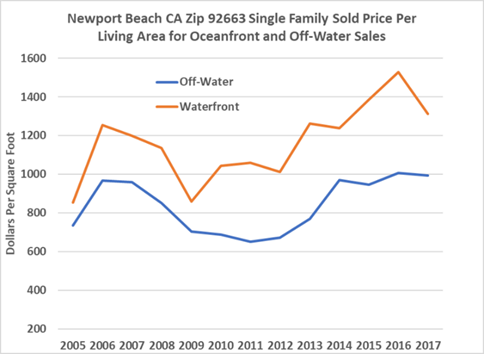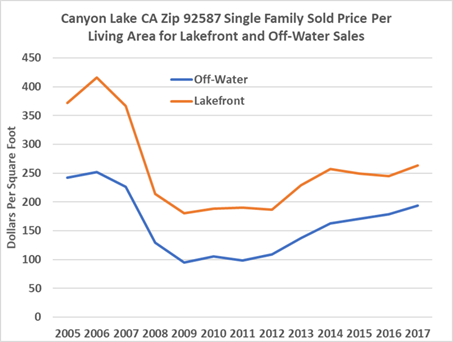by Dr. Michael Sklarz and Dr. Norman Miller | March 27, 2018
Download a PDF file of this research paper here.
Introduction
At Collateral Analytics we continuously work to improve our valuation models by incorporating new and better measures of those influences on value which, while exceptional in nature, create significant variation in valuation accuracy and levels. Property condition, school quality, and waterfront proximity are among our recent research efforts. Here we focus on water proximity, and those properties right on waterfront lots. Historically, water frontage has had a strong and positive influence on location value but in recent years, with global climate warming and greater flood risks, the question arises whether such negative influences offset the positive. That is a question we will address in a subsequent CA (Collateral Analytics) Research Article. Here we focus only on how water frontage impacts home values. We have used advanced GIS (Geographic Information Systems) techniques to identify and analyze data on approximately 1.2 million waterfront residential properties in the United States as of 2018. We combine this with several million transactions in the same ZIP Codes to estimate net waterfront effects on value.
While waterfront and unspoiled views are undoubtedly a cherished attribute, not all water is the same. For example, one of the attributes that makes waterfront valuable, is the view. However, each parcel will have a different view and the quality of this view will vary even in close proximity to the water. Other examples where the utility of waterfront and its impact on value vary could be water depth (for swimming or boating opportunities), water quality and purity, sound quality (such as the sound of breaking waves or the beating of pelican wings), the type of and color of water (lake, ocean, river, stream), fishing quality and access, and even the temperature of the water or air as temperature is stabilized by the water. Tests of waterfront premiums for the nation, as a whole, in the year 2018 indicate that waterfront does have a substantial premium but that it varies by the type of water (ocean, lake or river). Here we review those general differentials.
Prior Research on Waterfront Premiums
The most recent study on the impact of proximity to water is one by Jan Rouwendal, Or Levkovich and Ramona van Marwijk (2017).[1]
This study argues that waterfront properties get an upward biased coefficient of impact based on the correlation of waterfront locations with high quality home features. They compare home values for identical houses, at various distances from water. Their results show a significant impact of waterfront, but a smaller impact than many earlier studies. This provides support for the confounding role of property quality and its correlation with waterfront. On the other hand, if the objective is only to estimate market value and there are omitted variables, then over estimating the impact of water and in turn capturing the impact of some high-quality home amenities may still result in an accurate valuation.
Oceanfront, relative to rivers and lakes, has generally been demonstrated as having more impact on residential property value. One reason, aside from view, may be that, on the west coast of North America at least, there is a dramatic dampening of temperature variation from ocean proximity. This make summers mild and not too hot in locations like San Diego, from which the data was collected for a 2011 study by Steve Conroy and Jennifer Milosch. The authors included an analysis of general ocean proximity and found that the premium for proximity is nonlinear in distance from the coast. While it may be quite large for homes very close to the coast—possibly increasing the value for homes within 500 feet of the coastline by an estimated 101.9% (compared to all homes beyond six miles of the coast), falling to 62.8% for homes between 500 and 1,000 feet from the coast, and so on—results presented suggest that “the effect declines rapidly (falling to about 21.3% for houses between one and two miles off the coast), and ultimately becomes negligible beyond six miles from the coast.” [2]
In 1998, Earl Benson, Julia Hansen, Art Schwartz Jr., and Greg Smersh estimated price premiums for a variety of views and distance from water.[3] For the 1993 sample as a whole, views were found to generate an average 25.6% price premium. However, when views were classified into seven categories, the percentage increase in property value attributable to a view ranged from 8.2% for a poor partial ocean view, 18.1% for a lake view, 29.4% for a good partial ocean view, 30.8% for a superior partial ocean view, and 58.9% for an unobstructed ocean view. Lake frontage property, which provides recreational access as well as view amenities, added 126.7% to value. When property was very close to the ocean, premiums also rose. For example, an unobstructed ocean view adds 68.3% to value if the property is located within 0.1 miles to the ocean, but only 44.7% if the property is located a mile away from the water and 30.6% if located two miles from the water.
Based on prior research described above, it is clear that:
– Rivers and lakefronts are not as valuable as ocean fronts
– Oceanfront sites with waves are highly valued
– Larger lakes are better than smaller lakes
– The greater the radius of unobstructed views the better
– Proximity matters and the waterfront premiums decline rapidly after 60 to 100 meters
– Flood zones on rivers and lakes lower values slightly, but few studies have dealt with elevation risks from sea level rise.
New Empirical Analysis on Waterfront Valuation Impact
First, we estimate the net effect of being on a waterfront lot for property sales since the year 2000. We limit the data to a large sample of 5-digit ZIP Codes that include both waterfront and off-water sales. These waterfront properties were categorized into three types: ocean and bay front, lakefront, and riverfront. These classifications were based upon a proprietary database which Collateral Analytics created to identify and analyze waterfront properties across the entire U.S. using advanced GIS techniques.
General descriptive results: In Exhibit 1 below, we show the overall U.S. waterfront premiums where control for physical amenities such as living area, age, etc. and sale year.[4] The results show that oceanfront properties exhibit the highest premiums, nearly 45% over homes within the same ZIP Code but which are off-water, while lakefront homes show premiums of just over 25% and river front homes 24%. Of course, the quality of amenities may vary so these average premiums are likely to be biased slightly upward, but by less of a differential than previous studies that did not control for as many physical differences or used broader samples. Here we used only observations, several million, which were in ZIP Codes adjacent to water. We also found that the premiums vary by location. In Exhibit 2 we show the same descriptive result for several states.
Exhibit 1: Waterfront Residential Premiums by Type of Waterfront

Exhibit 2: Waterfront Residential Premiums by Type of Waterfront by State

In Exhibit’s 3, 4 and 5 below, we focus in on one particular ZIP Code, showing the average differential in residential single-family property transaction prices per square foot of living area, for three different ZIP Codes. The first is Newport Beach, oceanfront, with about a 40% premium as of 2016, the second is lakefront property on Canyon Lake, CA with a premium of about 22% as of 2017, and the third is Stockton, CA with a premium that has been declining for several years. Stockton is subject to flooding from the San Joaquin River, which has been subject to increasing floods in the last decade.[5]
Exhibit 3: Sample Oceanfront Historical Premium

Exhibit 4: Sample Lakefront Historical Premium

Exhibit 5: Sample Riverfront Historical Premium
The results for Stockton suggest the possibility of a decreasing premium for waterfront when the risks of floods are perceived as high or increasing. This is a topic which will be explored in our next CA Research Article.
Conclusions on Waterfront Premiums
Here we demonstrated that in most markets throughout the United States, waterfront or near waterfront properties continue to demand significant price premiums, even with the more nascent concerns over flood risks. These premiums on average are highest for oceanfront properties at nearly 45%, followed by lakes and rivers. It is true that the homes near water tend to be higher quality and teasing out the pure water effect is the subject of our ongoing research, but this important finding has already allowed us to improve our valuation models.
References
Benson, Earl D., Hansen, Julia L., Schwartz Jr., Arthur L., Smersh, Greg T. (1998) “Pricing Residential Amenities: The Value of a View.” Journal of Real Estate Finance and Economics, 16:1, pp. 55–73.
Bin, Okmyung and Jamie Brown Kruse, “Real Estate Market Response to Coastal Flood Hazards” Natural Hazards Review, 7:1, Nov. 2006
Conroy, Stephen J. and Jennifer Milosch, “An Estimation of the Coastal Premium for Residential Housing Prices in San Diego County.” The Journal of Real Estate Finance and Economics, 42:2, pp. 211–228, 2011.
Plattner, R. H., and T. J. Campbell. (1978). “A Study of the Effect of Water View on Site Value,” Appraisal Journal 46 (January), 20–25.
Rinehart, J. R. and J. J. Pompe, “Adjusting the Market Value of Coastal Property for Beach Quality,” The Appraisal Journal (October 1994): 604-608.
Rodriguez, M., and C. F. Sirmans. (1994). “Quantifying the Value of a View in Single-Family Housing Markets,” Appraisal Journal 62 (October), 600–603.
Udechukwu, C.E. (2010), “The Impact of Lagoon Water Views on Residential Property Values in Nigeria”, Lagos Journal of Environmental Studies, 2:2, 34-45.
Footnotes
[1] “Estimating the Value of Proximity to Water: When Ceteris Really Is Paribus?” by Jan Rouwendal, Or Levkovich and Ramona van Marwijk, Real Estate Economics, Vol 45:4 Winter, 2017 pp. 829-860.
[2] See Stephen J. Conroy and Jennifer Milosch, “An Estimation of the Coastal Premium for Residential Housing Prices in San Diego County.” The Journal of Real Estate Finance and Economics, 42:2, pp. 211–228, 2011.
[3] See Benson, Earl D., Hansen, Julia L., Schwartz Jr., Arthur L., Smersh, Greg T. “Pricing Residential Amenities: The Value of a View.” Journal of Real Estate Finance and Economics, 16:1, pp. 55–73.
[4] We use a standard hedonic model to control for the influences of physical attributes, the time of the sale and the general location. More detail is available in the academic version of this paper upon request.
[5] See for example, American Rivers, “The San Joaquin Demonstrates the Importance of Floodplain Restoration” Heavy storms and their subsequent
flooding in California’s San Joaquin basin highlight the importance of multi-benefit floodplain restoration. By Daniel Nylen | February 13, 2017 at
https://www.americanrivers.org/2017/02/flooding-san-joaquin-floodplain-restoration/
